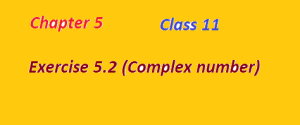Exercise 5.3(Complex Numbers and Quadratic Equations)
Solve each of the following equations:(Exercise 5.3 complex no. ncert math solution class 11)
Question 1: ![]() .
.
Solution : The given quadratic equation is ![]() .
.
![]()
![]()
![]()
Question 2: ![]() .
.
Solution: The given quadratic equation is ![]() .
.
On comparing the given equation with ![]() ,
,
we obtain ![]() , and
, and ![]()
Therefore, the discriminant of the given equation is given by
![]()
![]()
Therefore, the required solutions are
![]()
![]()
![]()
![]()
Question 3: ![]() .
.
Solution: The given quadratic equation is ![]() .
.
On comparing the given equation with ![]() ,
,
we obtain ![]() , and
, and ![]()
Therefore, the discriminant of the given equation is given by
![]()
![]()
Therefore, the required solutions are
![]()
![]()
![]()
![]()
Question 4: ![]() .
.
Solution : The given quadratic equation is ![]() .
.
On comparing the given equation with ![]() ,
,
we obtain ![]() , and
, and ![]()
Therefore, the discriminant of the given equation is given by
![]()
![]()
Therefore, the required solutions are
![]()
![]()
![]()
![]()
Question 5: ![]() .
.
Solution : The given quadratic equation is ![]() .
.
On comparing the given equation with ![]() ,
,
we obtain ![]() , and
, and ![]()
Therefore, the discriminant of the given equation is given by
![]()
![]()
Therefore, the required solutions are
![]()
![]()
![]()
![]()
Question 6: ![]() .
.
Solution: The given quadratic equation is ![]() .
.
On comparing the given equation with ![]() ,
,
we obtain ![]() , and
, and ![]()
Therefore, the discriminant of the given equation is given by
![]()
![]()
Therefore, the required solutions are
![]()
![]()
![]()
![]()
Question 7: ![]() .
.
Solution: The given quadratic equation is ![]() .
.
On comparing the given equation with ![]() ,
,
we obtain ![]() , and
, and ![]()
Therefore, the discriminant of the given equation is given by
![]()
![]()
Therefore, the required solutions are
![]()
![]()
![]()
![]()
Question 8: ![]() .
.
Solution: The given quadratic equation is ![]() .
.
On comparing the given equation with ![]() ,
,
we obtain ![]() , and
, and ![]()
Therefore, the discriminant of the given equation is given by
![]()
![]()
Therefore, the required solutions are
![]()
![]()
![]()
![]()
Question 9: ![]()
Solution : The given quadratic equation is ![]()
![]() .
.
On comparing the given equation with ![]() ,
,
we obtain ![]() , and
, and ![]()
Therefore, the discriminant of the given equation is given by
![]()
![]()
![]()
![]()
Therefore, the required solutions are
![]()
![]()
![]()
![]()
Question 10: ![]()
Solution: The given quadratic equation is ![]()
![]() .
.
On comparing the given equation with ![]() ,
,
we obtain ![]() , and
, and ![]()
Therefore, the discriminant of the given equation is given by
![]()
![]()
![]()
Therefore, the required solutions are
![]()
![]()
![]()
![]()

